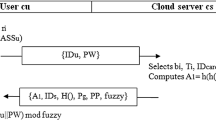Abstract
A new geometry-based authentication and key agreement scheme, without invoking traditional strong symmetric and/or asymmetric encryption functions, is constructed by taking advantage of the geometric property that (n + 1) generic points in an n-dimensional space can determine a unique hyper-sphere under certain conditions. The security and performance of the scheme are analyzed. Experiments are also conducted to show that the scheme is efficient and is easy to implement.
Access this chapter
Tax calculation will be finalised at checkout
Purchases are for personal use only
Preview
Unable to display preview. Download preview PDF.
Similar content being viewed by others
References
Das, A.: A secure and effective user authentication and privacy preserving protocol with smart cards for wireless communications. Networking Science, 1–16 (2012), http://dx.doi.org/10.1007/s13119-012-0009-8
Guo, C., Chang, C.: Chaotic maps-based password-authenticated key agreement using smart cards. Communications in Nonlinear Science and Numerical Simulation 18(6), 1433–1440 (2013), http://www.sciencedirect.com/science/article/pii/S1007570412004698
Chien, H.-Y., Jan, J.-K., Tseng, Y.-M.: A modified remote login authentication scheme based on geometric approach. Journal of Systems and Software 55, 287–290 (2001)
Wang, S.H., Bao, F., Wang, J.: Comments on yet another log-in authentication using n-dimensional construction. IEEE Transaction on Consumer Electronics 50, 606–608 (2004)
Hwang, M.S.: Cryptanalysis of a remote login authentication scheme. Computer Communications 22, 742–744 (1999)
Juang, W., Chen, S., Liaw, H.: Robust and efficient password-authenticated key agreement using smart cards. IEEE Transactions on Industrial Electronics 55(6), 2551–2556 (2008)
Lennon, R., Matyas, S., Meyer, C.: Cryptographic authentication of time-invariant quantities. IEEE Transactions on Communications 29(6), 773–777 (1981)
Li, X., Qiu, W., Zheng, D., Chen, K., Li, J.: Anonymity enhancement on robust and efficient password-authenticated key agreement using smart cards. IEEE Transactions on Industrial Electronics 57(2), 793–800 (2010)
Li, X., Ma, J., Wang, W., Xiong, Y., Zhang, J.: A novel smart card and dynamic id based remote user authentication scheme for multi-server environments. Mathematical and Computer Modelling (2012), http://www.sciencedirect.com/science/article/pii/S0895717712001720
Luby, M., Rackoff, C.: A study of password security. Journal of Cryptology I, 151–158 (1989)
Menkus, B.: Understanding the use of passwords. Computers and Security 7, 132–136 (1988)
Sun, D., Huai, J., Sun, J., Li, J., Zhang, J., Feng, Z.: Improvements of Juang et al ’s password-authenticated key agreement scheme using smart cards. IEEE Transactions on Industrial Electronics 56(6), 2284–2291 (2009)
Wang, S.J.: Yet another login authentication using n-dimensional construction based on circle property. IEEE Transaction on Consumer Electronics 49, 337–341 (2003)
Wang, S., Chang, F.: Smart card based secure password authentication scheme. Computers and Security 15, 231–237 (1996)
Wu, T.C.: Remote login authentication scheme based on a geometric approach. Computer Communications 18, 959–963 (1995)
Yang, F.Y., Jan, J.K.: Cryptanalysis of log-in authentication based on circle property. IEEE Transaction on Consumer Electronics 50, 625–628 (2004)
Yang, W., Shieh, S.: Password authentication schemes with smart cards. Computers and Security 18, 727–733 (1999)
Zhang, L., Tang, S., Cai, Z.: Efficient and flexible password authenticated key agreement for voice over internet protocol session initiation protocol using smart card. International Journal of Communication Systems (2013), http://dx.doi.org/10.1002/dac.2499
Author information
Authors and Affiliations
Editor information
Editors and Affiliations
Rights and permissions
Copyright information
© 2013 Springer-Verlag Berlin Heidelberg
About this paper
Cite this paper
Tang, S., Xu, L. (2013). Authentication and Key Agreement Based on Hyper-sphere Using Smart Cards. In: Lopez, J., Huang, X., Sandhu, R. (eds) Network and System Security. NSS 2013. Lecture Notes in Computer Science, vol 7873. Springer, Berlin, Heidelberg. https://doi.org/10.1007/978-3-642-38631-2_40
Download citation
DOI: https://doi.org/10.1007/978-3-642-38631-2_40
Publisher Name: Springer, Berlin, Heidelberg
Print ISBN: 978-3-642-38630-5
Online ISBN: 978-3-642-38631-2
eBook Packages: Computer ScienceComputer Science (R0)




